Carpets are the perfect accent to any room if you want to add to your interior décor. They’re also perfect for insulation during cold months. But how long does carpet last?
On average, carpet that is installed properly will last 10 years.
However, there are many factors which we discuss below that can affect how soon a carpet needs to be replaced.
This complete guide discusses the 10 most important factors on how long a carpet will last. In addition, we provide our a list of the most durable brands and costs you should expect if you decide to replace your carpet.
Carpet Advice
10 Key Factors That Affect Carpet Longevity
1. Type of Carpet
The type or style or carpet you choose has a direct impact on how long it will last.
| Carpet Type | How Long It Will Last | What We Think About Durability |
| Loop Pile | 10+ years | Looped, uncut yarn makes it a durable choice for high traffic areas |
| Cut Pile | 10+ years | Very durable, try to get the tightest twist level for durability |
| Cut & Loop | 8+ years | A little less durable than loop carpet |
| Cable | 5+ years | Longer yarn is used that crushes easily, not for high traffic areas |
| Berber | 15+ years | Looped fibers do not allow spills to set into the carpet |
| Plush/Saxony | 5+ years | Smooth, velvet type look that looks good, but not meant for busy areas |
2. Carpet Fibers
There are three materials that are used to make carpeting: nylon, wool, and olefin. In this section we will provide the benefits and drawbacks of each material so you can decide which one works best for your home.
We also discuss which carpet material lasts the longest.
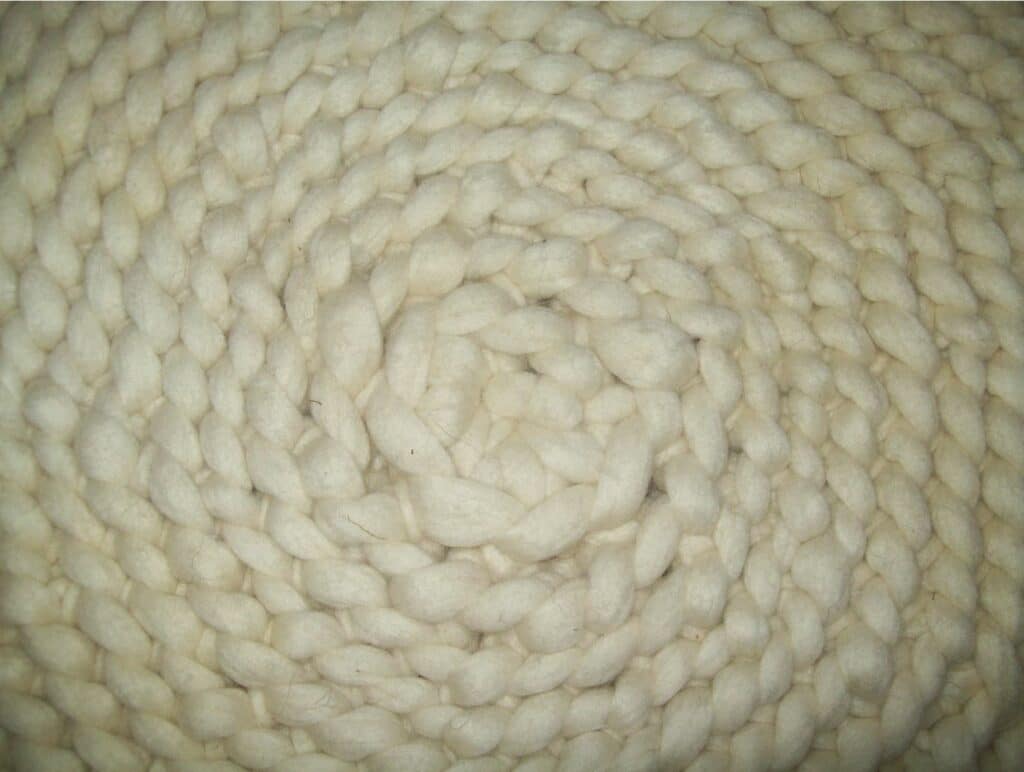


Nylon Carpeting
Nylon is an artificial fiber that’s incredibly strong and can be made into soft, textured threads. It’s one of the most popular carpeting materials on the market because it’s resistant to abrasions and has excellent retention. This simply means that nylon is able to keep its original shape, so the fibers don’t go flat when you walk on them.
Nylon is often considered the best carpet for high traffic areas. It helps prevent matted carpet which gives a flat visual appearance.
Floor rugs made from nylon come in a variety of colors and textures to choose from, and they’re versatile too.
Wool Carpeting
Unlike nylon, wool is an all-natural fiber that’s strong and won’t shed easily. Woolen rugs or carpets are easy to maintain, so they’re perfect for people who have pets and children. Since wool fibers are durable, carpets made from this natural fiber are ideal for areas that have high foot traffic such as the following:
- Hallways
- Restaurants
- Living rooms
- Conference rooms
- Bedrooms
On the other hand, if you pick woolen carpets you may want to avoid using bleach to clean them. There are mild carpet cleaning detergents on the market that are specially formulated for woolen rugs.
Olefin Carpeting
Olefin is another popular synthetic product used to manufacture carpets. Fibers made from olefin won’t stain easily, and the material can withstand many types of spills, from fruit juice to bleach. However, his material doesn’t have a high retention rate, so it doesn’t keep its shape well.
Since olefin is so durable and can withstand harsh environments, this material is used to make both indoor and outdoor rugs.
Which Carpet Material Lasts the Longest?
The carpet material that lasts the longest is nylon. This synthetic fiber material can withstand the following:
- Pet hair and spills
- High foot traffic
- UV rays
- Frequent vacuuming
- Messy children
Wall-to-wall carpeting made from 6.6 nylon are considered the best choice for homes because of their incredible strength. They’re also effortless to maintain. A high-quality nylon carpet, whether it’s wall-to-wall or a throw rug, will last between 12 and 15 years.
3. Wear & Tear From Usage
When you walk around outside, soil, sand, and other types of debris stick to the bottoms of your shoes. Soil and sand are abrasive, so when you tread this type of dirt onto your carpet, it can cause significant wear over time. Abrasive debris is similar to sandpaper and rubs or scrapes the fibers down, causing patches to form on the surface of the rug.
However. it’s not only sand and shoes that cause patches and scuff marks on carpets. Heavy furniture, toys, and other items dragged across your carpet can cause it to wear over time. Rips can also be caused by dragging heavy items over the surface. Other types of carpet damage include stains from spilling food or drinks and burn holes from cigarettes.
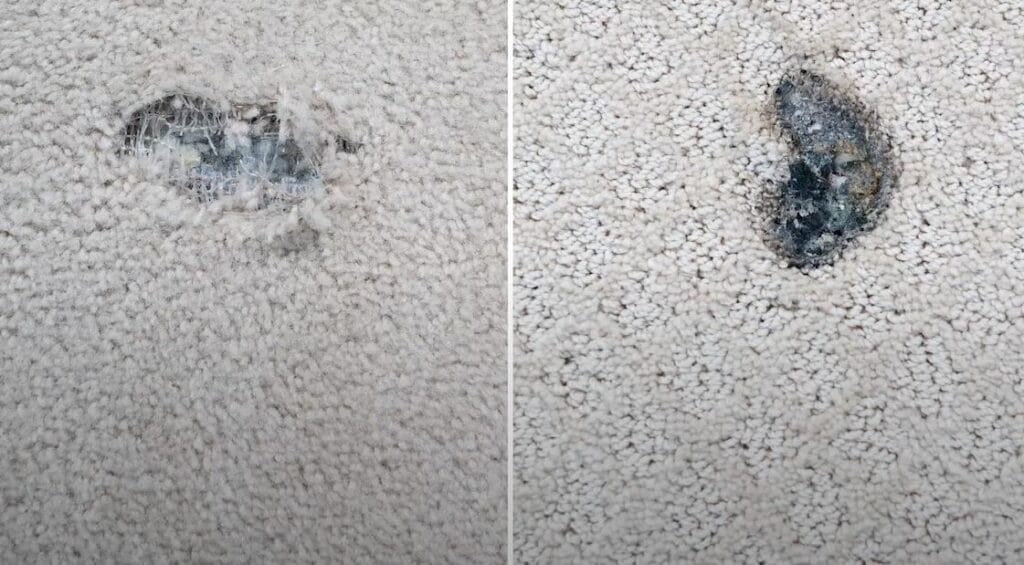
Mold growth can be caused by high humidity levels or water damage. On the other hand, high-quality carpet brands are more durable and won’t tear easily, but we recommend drying your carpets thoroughly when washing them to prevent mold growth.
High traffic areas of your home such as hallways, front entryways, stairways, and play areas will wear and fade out much sooner. You can tell if an area is wearing by looking for wrinkles or pile heights that are lower when compared to other parts of the carpet.
In many cases, you can simply replace the areas that are worn out versus replacing all of the carpet. It’s always a good idea to purchase extra carpet so you have the exact style and color on hand if replacing small patches.
Alternatively, if you do not want to replace your carpet, you could place a rug or mat over the area.
4. Stains and Smell
If your existing carpet has had frequent spills or accidents from kids or pets, it may be time to replace your carpets. Often with stains that have not been properly cleaned with a steam cleaner, will leave a nasty odor. The odor exists as the stain has penetrated the carpet padding or even the subfloor.
If the carpet is relatively new, you will probably want to try to get it professionally cleaned. Otherwise, if the carpet it nearing the end of its useful life you should consider replacing it.
5. Carpet Padding
It is not easy cleaning carpet padding and that can lead to needing carpet replacement. Most vacuums and even some steam cleaners do not clean below the carpet fiber into the padding. Therefore, you may not notice stains or smells right away.
If you smell a lingering odor or notice that your carpet makes a sound when you walk over it, the issue could likely be the carpet padding. You should first attempt to try to clean the carpet padding. An easy at home solution is to mix four parts water with one part white vinegar. Note you will need to pull up the carpet from one of the corners.
Remember that is very important to have carpet padding. According to the Carpet Cushion Council, a test was run where a chair with a 150 pound weight ran over carpet 20,000 times. The study found that the carpet with no cushion lost pile height by 19.3% while the carpet with padding only lost pile height by 5-10%.

6. Furniture and Heavy Objects
Dragging heavy furniture or other objects across your carpet may seem like an efficient way to move things, but it can ruin your carpet. It can cause holes, snags, or tears that in most cases an only be fixed by replacing the carpet.
Some simple ways to move furniture on carpet is to use cardboard, plastic lids, or even a frisbee. Alternatively, you can buy a furniture slider for carpet.
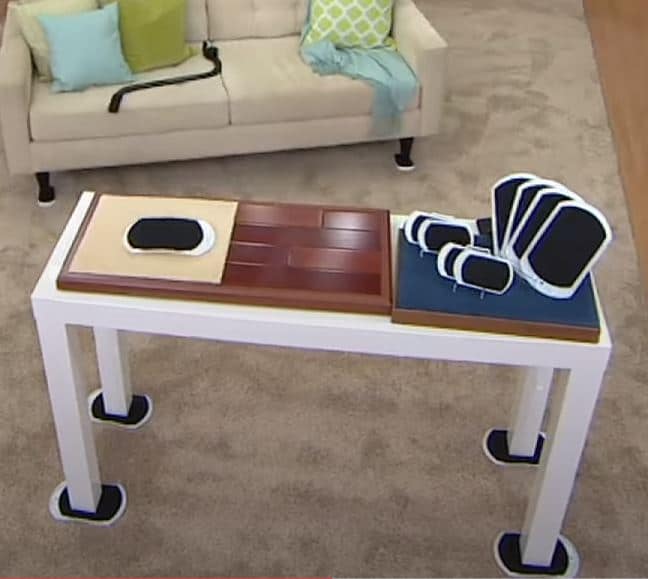
7. UV Rays
Frequent and constant exposure to the sun is one of the main reasons for a carpet to fade. Once a carpet had started to fade from the sun, there is no way to bring it back to life.
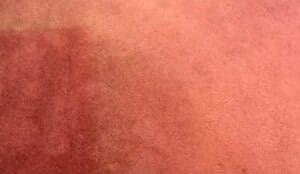
To prevent UV damage you can do one of the following:
- Install solar shades and remember to keep them down when the sun is directly shining on your carpet
- Put UV treatments on your windows. According to 3M, they can block out 99% of harmful UV rays.
- Protect your carpets with Fluorocarbon. This will help your carpet from fading and will also help prevent stains.
8. Water Damage
With water damage on carpet, it comes down to how long the carpet has been exposed to water. Generally, if a carpet has been soaked for over 48 hours, the chances of being able to save the carpet are low. The risk of developing mold and mildew are very high and we feel in most cases, the heath risk is too great.
If you do choose to try to clean the carpet it must be shampooed, disinfected, and dried thoroughly. There is no guarantee the carpet will be useable and there is also a chance it will fade or stretch.
9. Fraying of Carpet Fibers
Fraying occurs when dirt and other particles make their way into the carpet fibers and cause friction when walked on.
If fraying is limited to a small area, it is generally pretty easy to fix. You can trim down loose threads and use a hot glue gun to reattach threads.
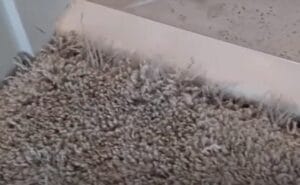
10. Allergy Symptoms
Mold, dust, and animal dander are all items that can get trapped in carpets. This can cause people with allergies to experience itchy eyes, sneezing, runny nose, and many other symptoms.
If you have allergies opt for low-pile carpet as it has tighter and shorter weaves so allergens have less area to get trapped in.
Most Durable Carpet Brands Currently on the Market
Below you will find three of our top brands for carpet. There are many brands and thousands of styles to choose from. If you need help finding the right carpet or with installation, please contact us.
Mohawk SmartStrand
- Durability: A-
- Styles: A
- Comfort: B+
- Cost: B+
- Stain Resistance: A
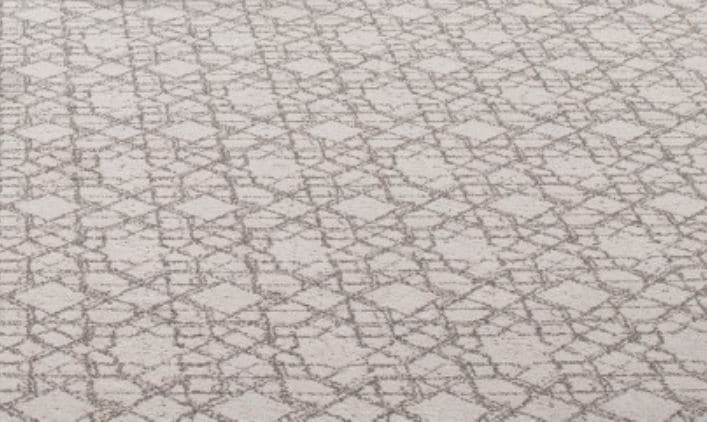
Mohawk Industries was founded in 1878 in New York, which makes this company one of the oldest carpet brands in the business. The company manufactures carpets for residential and commercial areas. This brand has a continuum technology that’s a softer and more robust polyester material.
The company produced a collection called SmartStrand that is designed to withstand harsh environments. It is made from Triexta (a synthetic material developed by DuPont), which according to Mohawk, will perform just as well as the nylon. So if you have messy pets and children, this Mohawk Industries floor covering will be ideal for your home.
Shaw Serene Key
- Durability: A-
- Styles: B+
- Comfort: B+
- Cost: B-
- Stain Resistance: A
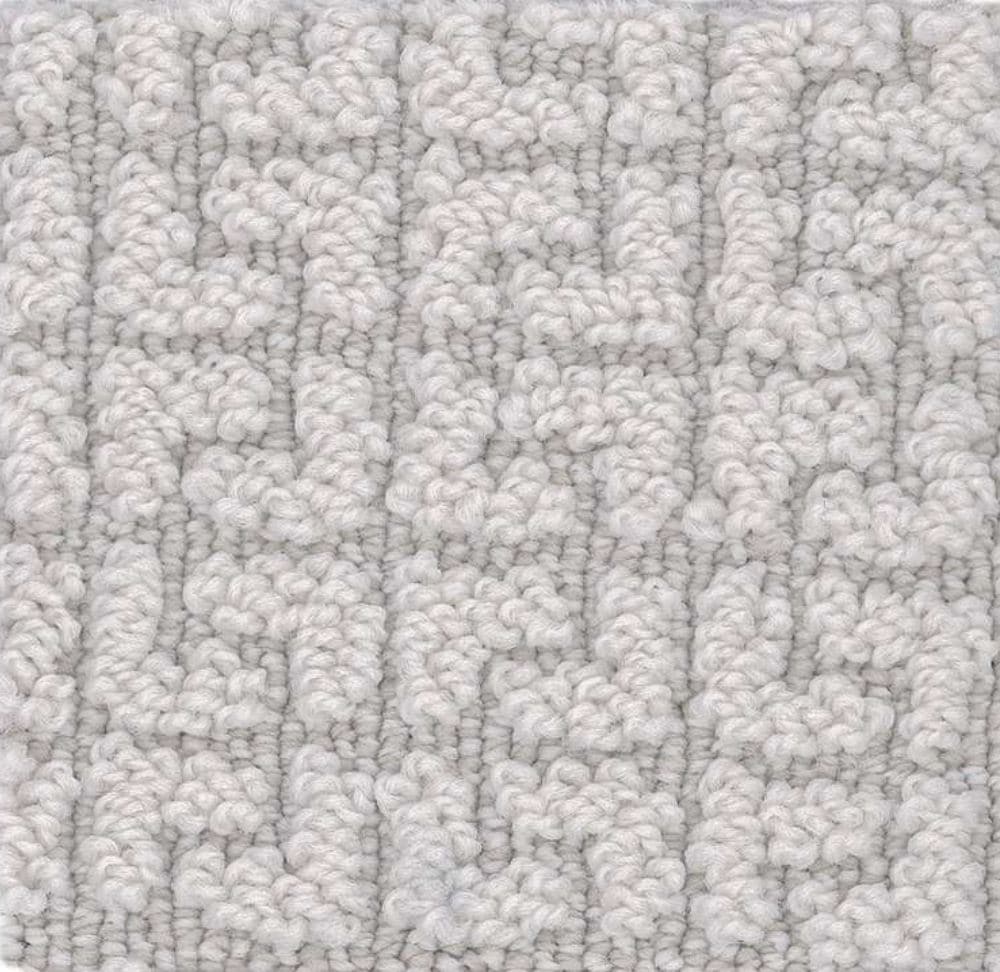
Shaw Flooring is a brand that has been in the industry since 1946, and it’s one of the biggest carpet manufacturers you can find. The company offers top-notch service, high-quality products, and a variety of flooring options for you to pick from.
Shaw Flooring’s products include R2X stain resistance and LifeGuard. The R2X stain-resistant carpets from Shaw are resistant to soil damage and of course stains of any kind. LifeGuard is a waterproof carpet that’s resistant to mold and water damage.
You’ll appreciate that Shaw Flooring has sustainable carpet practices where you can recycle your old floor covers to make new ones.
Stainmaster PetProtect
- Durability: B
- Styles: A-
- Comfort: B+
- Cost: A
- Stain Resistance: B
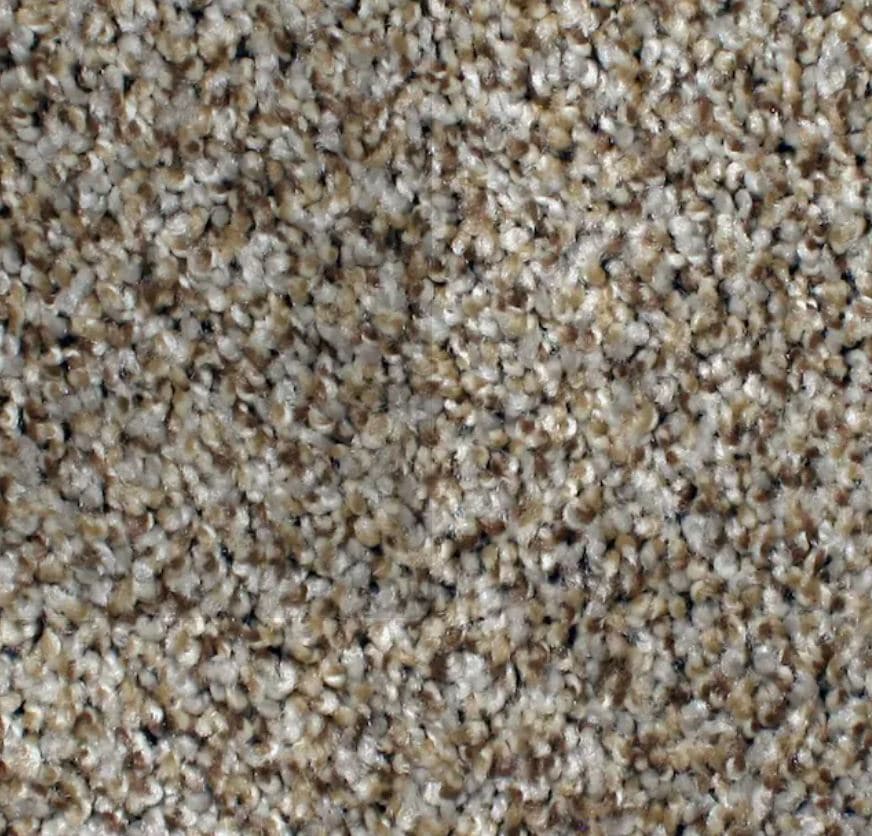
DuPont launched Stainmaster in 1986, and the brand offered 6.6 nylon carpets to consumers. Stainmaster is now a division of Lowe’s.
Stainmaster has a list of high-end products, namely TruSoft and Active Family.
The TruSoft line is exceptionally soft, and the fibers feel luxurious under your feet and when you sit on it. It’s also stain-resistant and robust, so it won’t wear or tear over time. Stainmaster’s Active Family carpet is durable and stain-resistant, and therefore suitable for people with children and pets.
Carpet Repair Cost
There are two main costs to consider when replacing your carpet: material cost and installation cost. There is a wide range in costs based on the type of carpet you choose, the brand, your location, size of your project, and whether you choose to do it yourself or hire a contractor.
We often get asked when is the best time to buy carpet. We suggest you do an annual or semi-annual check of your carpets and see if you anything can be done to slow down the wear on problem areas. In terms of finding the best deal, carpet stores run various promotions all year around. It’s more important to due your diligence and choose the most durable carpet you can afford vs. finding the cheapest one.
Below you will find our cost summary. Refer to our detailed carpet cost guide for more in-depth cost data.
| Carpet Material | Carpet Cost (per sq. foot) | Padding Cost (per sq. foot) | Tools & Supplies Cost | Total Price (500 square feet) |
| Nylon | $1 to $5 | $1 to $2 | $78 – $895 | $1,078 to $4,395 |
| Polyester | $1 to $3 | $1 to $2 | $78 – $895 | $1,078 to $3,395 |
| Olefin | $2 to $4 | $1 to $2 | $78 – $895 | $1,578 to $3,895 |
| Wool | $4 to $12 | $1 to $2 | $78 – $895 | $2,578 to $7,895 |
Read More: How to Clean Carpet
FAQs
The average life of a carpet is 10 years. But for your carpet to last this long, you must take care of it and do the necessary maintenance work to keep it in tip-top shape. Even with extensive care, there will be parts of your carpet that will show signs of wear after 10 years.
You may start to notice patches of missing fibers where people walk the most. Your carpet will start to lose color, and it will look faded in some places. You’ll notice fading even more so if you have a patterned carpet. Old carpets will also start to lose cushioning and will stain easily.
If you find that it’s become increasingly difficult to remove stains from your rugs, then it’s time for you to get new ones.
How Often Should Carpet Be Replaced?
Carpets can be replaced between every 5 and 15 years depending on the quality of your carpet and how much padding it has. This padding is the foundation of your carpet that makes it more comfortable to walk on. Additionally, the foundation of your floor covering deters sound, which works well if you have wooden boards underneath the carpets.
However, the drawback to carpet padding is that it absorbs liquids. Even if you deep clean your carpets regularly, you won’t be able to get the padding clean. After a while, the padding will start to wear, or it could harbor mold.
That’s why it’s extremely important to replace your carpets when they become old and tattered. There are some affordable carpet brands out there, so you can re-carpet your floors even when you’re on a budget.
What’s more, laying down carpet is a lot cheaper than installing laminate or wood floors. Replacing old floor coverings with new, high-quality carpets will add elegance to your interior designs.
New carpets feel luxurious and have a pleasant fragrance. Simply removing old carpets from your home can make the area instantly smell better.
Can Old Carpet Make You Sick?
Yes, old carpets can make you sick, especially if you’ve had water damage in the past and there’s mold growing in between the fibers. Old carpets can cause respiratory infections and even stomach illnesses.
Your skin can be affected by old rugs, too. Eczema and athlete’s foot are common skin problems caused by old floor coverings. If you notice a rash forming on your skin every time you sit or walk on your floor, it could mean your carpet is causing the skin condition.
The old carpet can also cause a weakened immune system because your body is constantly fighting against the toxins and dirt being kicked up from your old floor covering. That’s why it’s important to replace your carpets after the expiration date, especially if you have children and pets. You don’t want your pets and your family to get sick from a worn out carpet.
How Many Times A Year Should You Clean Your Carpet?
You should vacuum your carpets every week to remove dust and other small dirt particles from the fibers. However, you should wash your carpets every three to six months, especially if there are many stains on the surface.
If your carpets tend to get extremely dirty, you’ll need to deep clean them with an industrial machine twice a year. Or you can hire a carpet cleaning service to assist you. A deep clean will pull all the dirt and stains hidden deep within the fibers to clean them out thoroughly.
Once you’ve cleaned your carpets, you must stay off of them until they are completely dry. If you walk over your floor coverings when they’re still wet, you’ll put marks all over them. To dry your carpets quicker, leave all your windows open or place a fan inside the room.
There are machines that suck up most of the moisture left behind after washing carpet and rugs. But they don’t completely dry them. To prevent mold growth or mildew buildup, use a high-powered fan to dry the fibers.
Another aspect to remember is that synthetic carpets dry faster than natural fiber coverings. So if you want to have carpets that won’t take time to clean or dry, then consider nylon products.
How Can You Make Your Carpet Last Longer?
To make your carpets last longer, you must maintain them regularly. Vacuuming your carpets weekly will remove abrasive dirt that causes fiber wear. Additionally, you should dust around your house regularly so that the dirt doesn’t fly off surfaces and settle on your flooring.
Spot cleaning is essential in proper carpet care. If there’s a spill on the carpet, you should clean it up as quickly as possible to prevent the liquids from seeping deep into the carpet. To safely lift stains off of your rugs, you can use a high-powered cleaning agent.
Another way you can make your floor covers last longer is by placing area mats down where there is high foot traffic. You can put clear mats down so that it doesn’t affect the aesthetics of your interior décor.
Lastly, use a dehumidifier in your home if you live in an area with high humidity, to prevent mold growth in the fibers of your carpet. It’s important to keep your home well-ventilated when you have wall-to-wall floor covers.
Is It Quicker To Install Carpets Or Hardwood Floors?
It’s quicker to install carpeting than it is to install hardwood floors. It usually takes about a day to install carpets, depending on the size and shape of your floors. For hardwood floors it can take up to five days to complete installation.
However, hardwood floors last for up to 25 years or longer, whereas carpets only last between 10 and 15 years. But carpeting is a lot cheaper and there’s a lot you can do with it. For example, if you want an alternating look in every room, you can install a different color or pattern design in each area. This can add a unique aesthetic to your home.
If you want a consistent look throughout your house, then it’s advised to use the same color or patterned carpeting in every room. Make sure the carpets line up perfectly if you’re installing them in stages, especially if there are patterns on the surface.
Do You Need to Remove Furniture Before Doing Carpet Installations?
Yes, you need to remove all furniture from the room before you install your carpets. If you lay your flooring around furniture it will look untidy.
And if you’re asking, “How long does carpet last?” you can reduce the average number of years if you install the carpets incorrectly. They will start ripping or tearing where you haven’t placed tack strips. So always install carpets from wall to wall to prevent premature wear and tear.
Final Thoughts
Again, on average, a carpet should last at least 10 years. It comes down to doing your research on the type of carpet, the traffic you accept it to receive, and the maintenance you provide.
Carpets can add to the aesthetics of your home if you pick the right colors and designs. They’re comfortable to sit on and provide safer flooring for children to walk and play on. We recommend you choose synthetic carpeting for your home because it’s easier to clean and highly durable.
If you have any further questions on how long carpet lasts or other questions about flooring then leave a message below or contact us. We would be happy to help you.
Back to Top